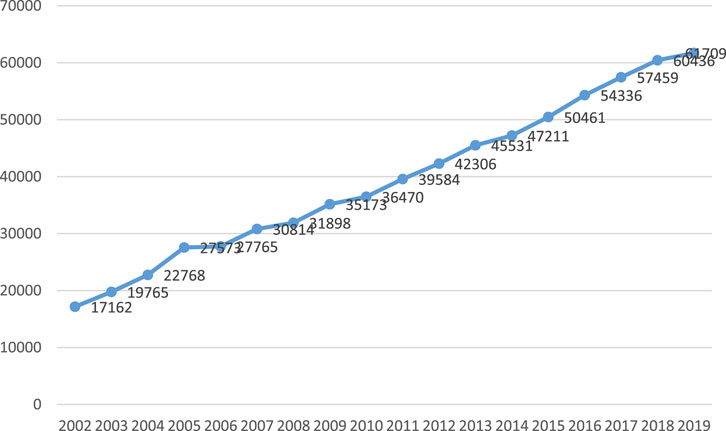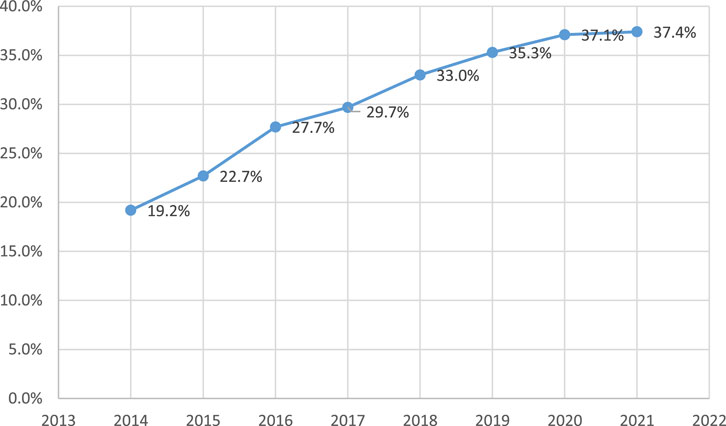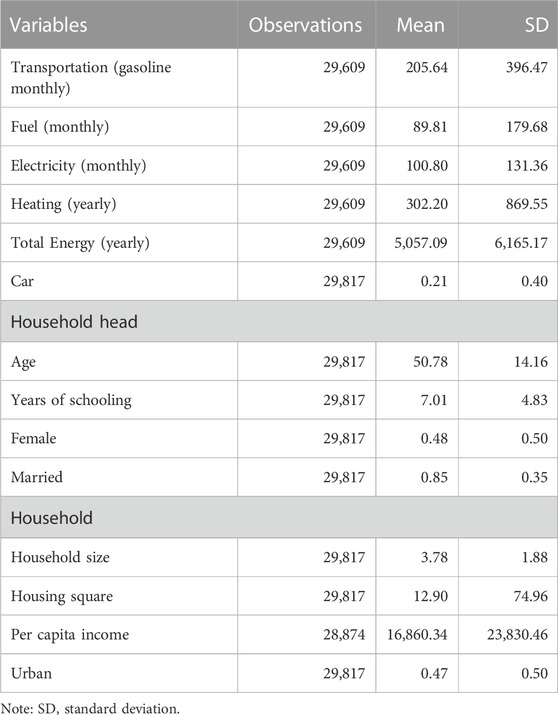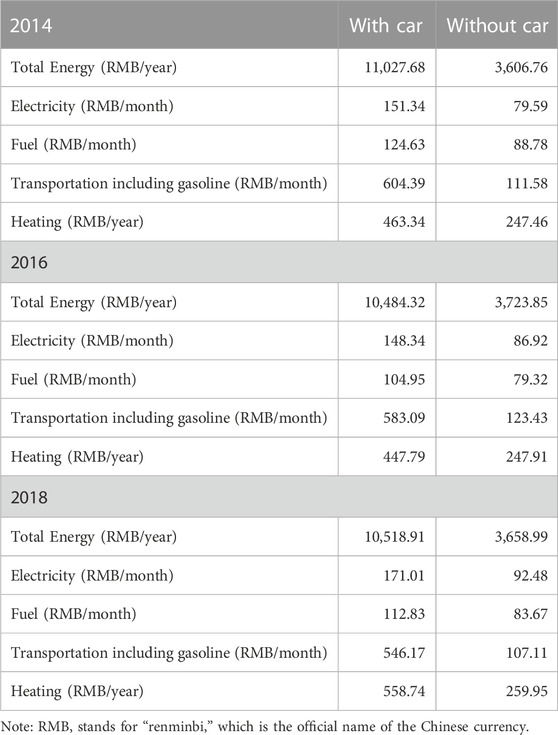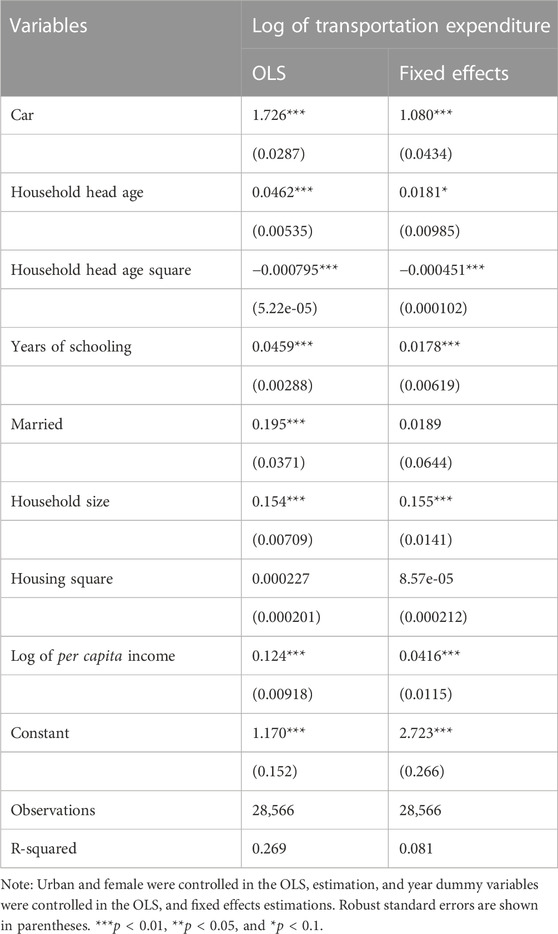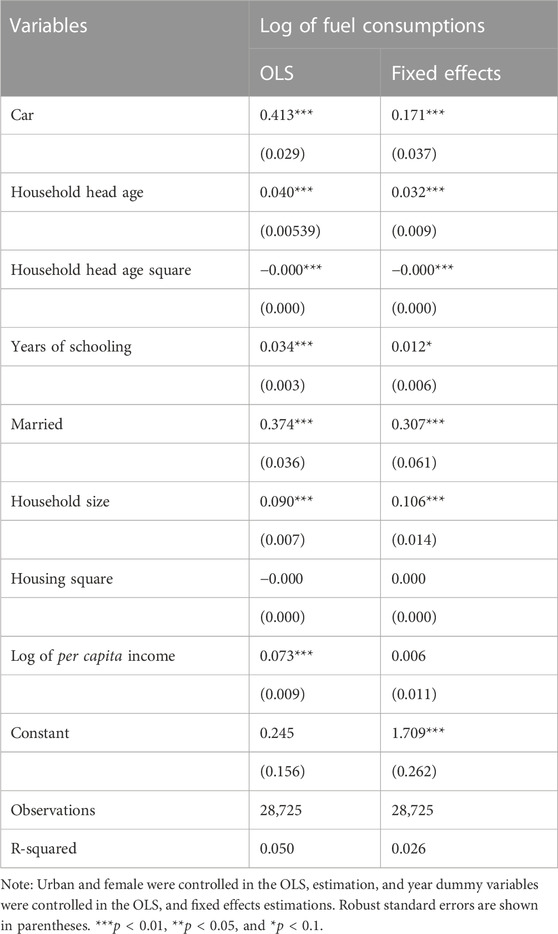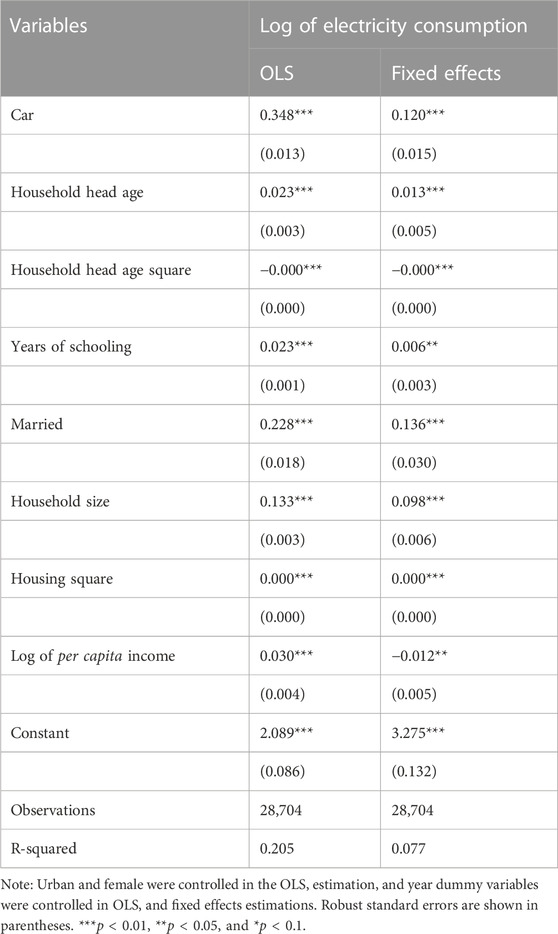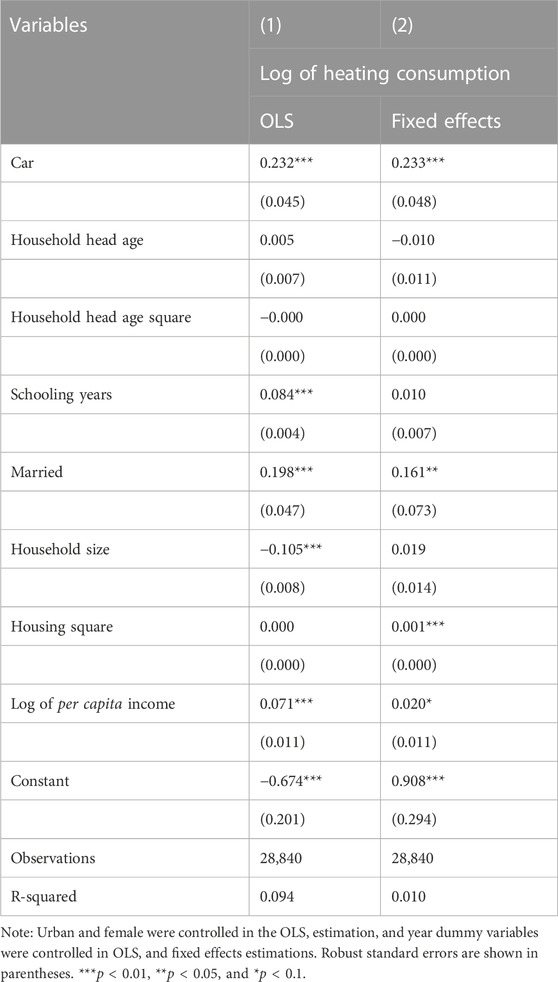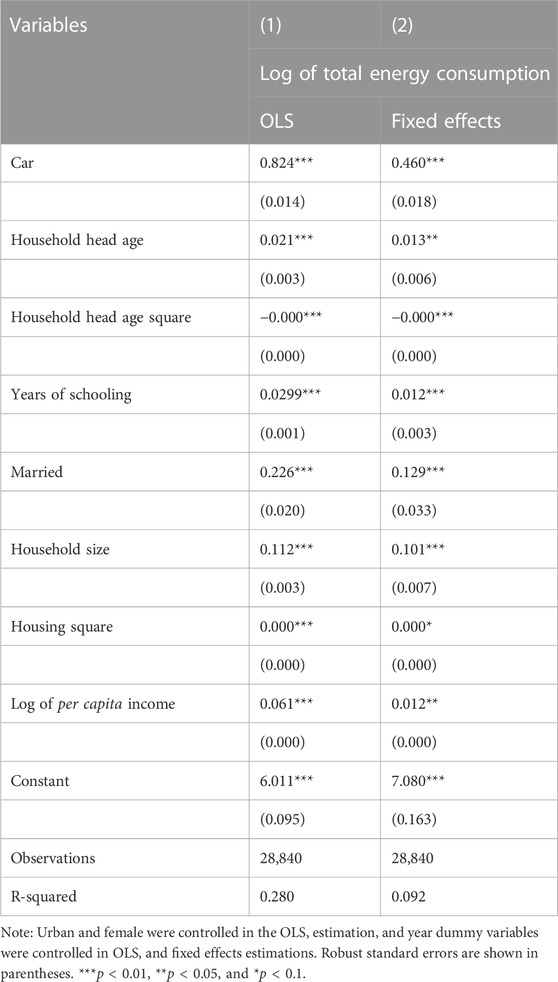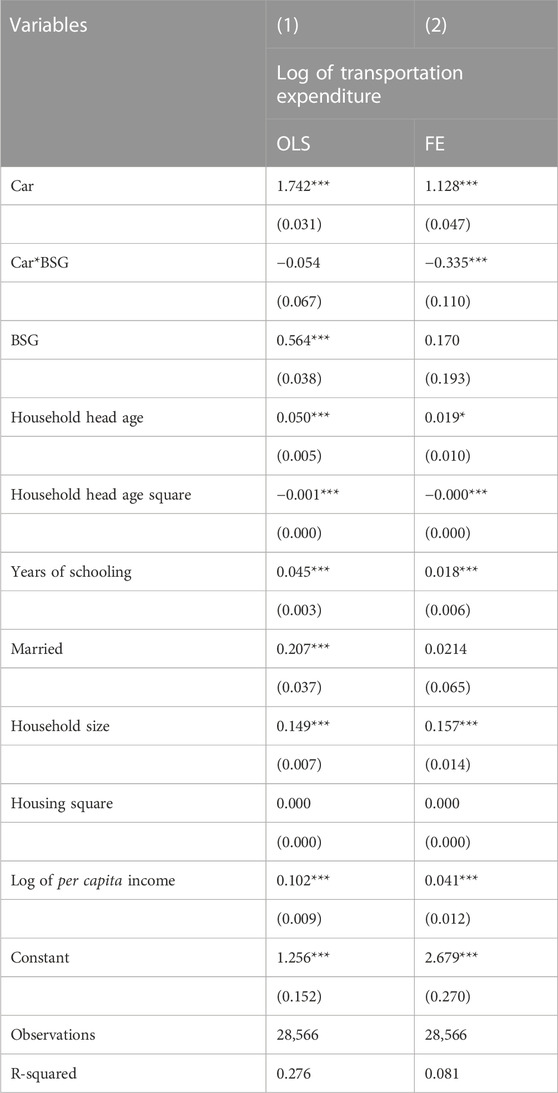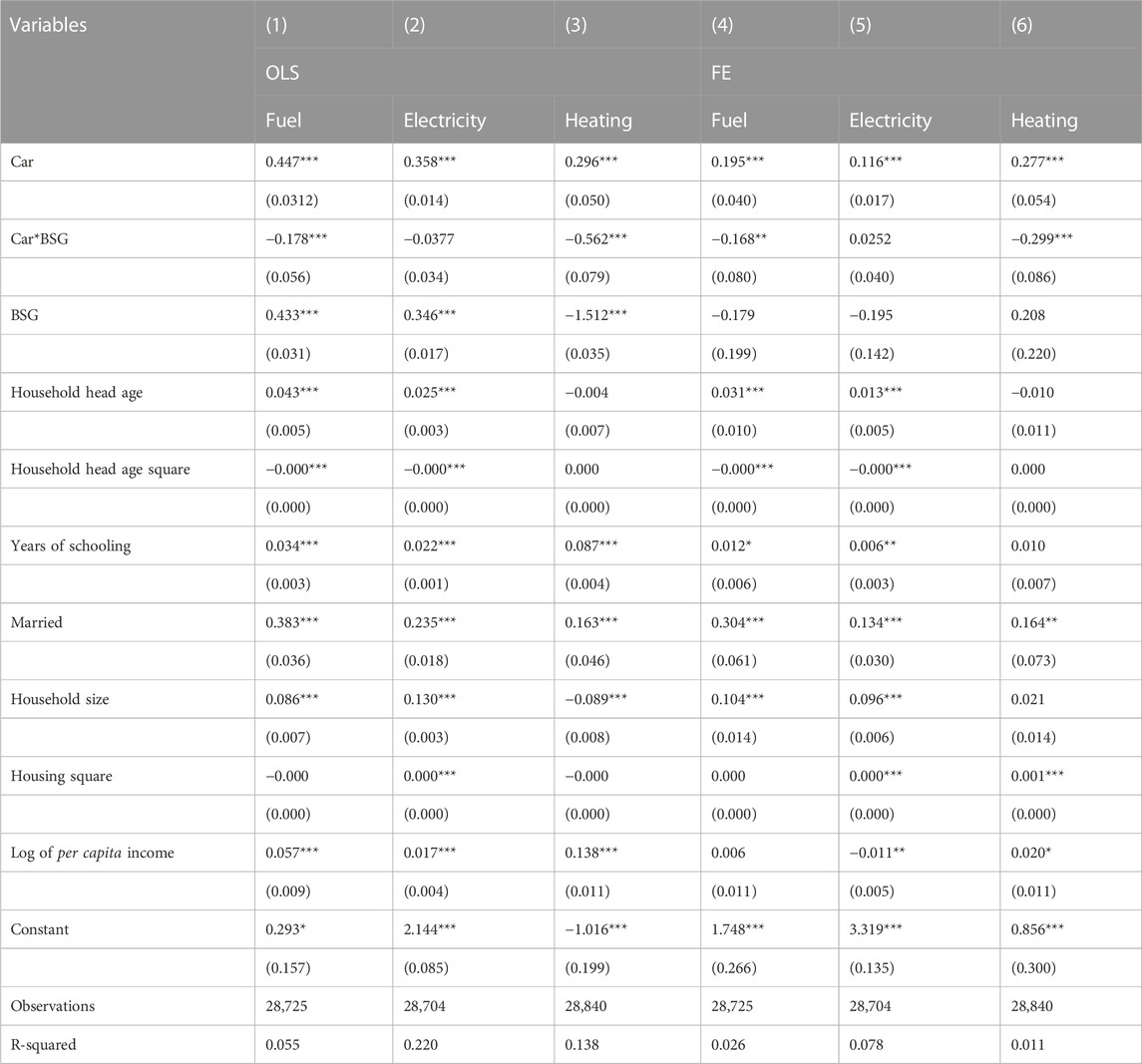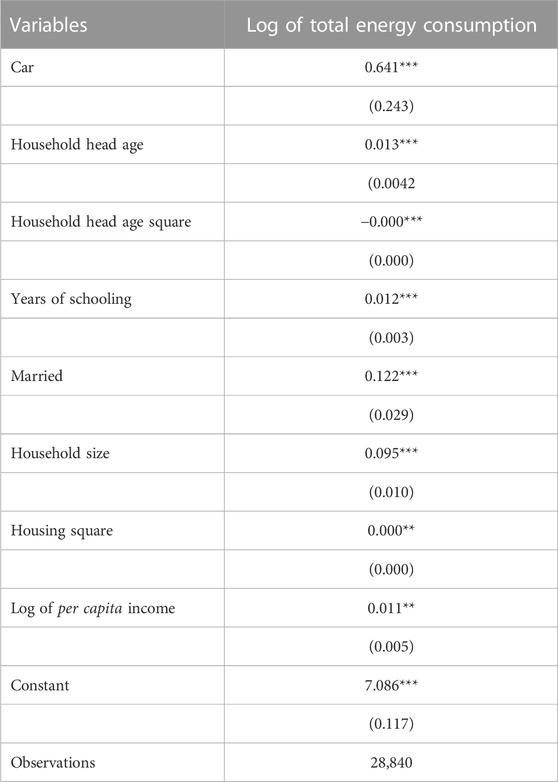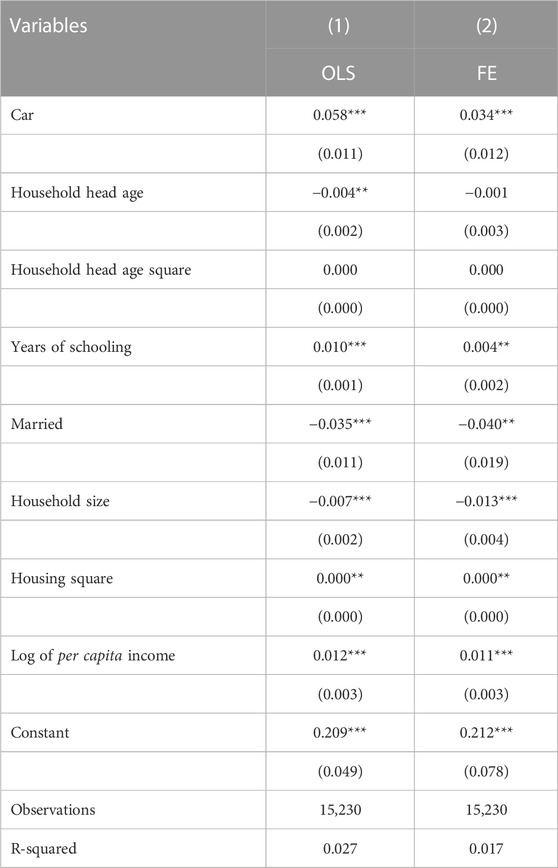- School of Energy Resources, China University of Geosciences, Beijing, China
Based on survey data from Chinese households, this study uses a fixed effects model to examine the impact of car ownership on household energy consumption. The results show that car purchases lead to a significant 46% increase in household energy consumption costs. Purchasing cars leads to a 108% increase in household transportation expenditure (including gasoline expenditure), showing a significant direct effect, while heating costs increase by 17.1%, 12.0%, and 23.3%, respectively, representing an indirect effect. Furthermore, in regions with rapid EV growth, EVs have alleviated the promotion of cars in energy consumption, which is conducive to achieving the goal of carbon neutrality. This study helps provide measures to reduce future household energy consumption and promote the realization of carbon neutrality.
1 Introduction
The goal of carbon neutrality is closely related to household consumption behavior. Pro-environmental behavior is a popular topic at present (Grilli and Curtis, 2021). In China and numerous emerging economies, energy consumption has risen with rapid economic expansion over the past few decades, alongside a rapid increase in carbon emissions per capita (Shahbaz et al., 2013). In 2021, China’s total energy consumption reached 5,240 million tons of standard coal. Living energy consumption increased by an average of 7.82% annually, from 17,162 thousand tons of standard coal in 2002–61,709 thousand tons of standard coal in 2019. This increase shows that households are becoming significant energy consumers. Thus, the energy consumption of Chinese households is rising rapidly, as depicted in Figure 1. As one of the world’s largest carbon emissions economies, it is essential to implement policies and deploy responsible supply chains to balance quality (Niu et al., 2021; Liang et al., 2012). Household energy consumption, the use of fossil fuels such as coal, oil, and natural gas releases greenhouse gases into the atmosphere, causing the Earth to warm. Therefore, reducing household energy consumption is key to mitigating climate change.
In this study, we explore Chinese households’ behavior and its contribution to carbon emissions from the perspective of total energy consumption. We find that buying cars is associated with a 46% increase in a household’s total energy bill. The inflated bill is a result of gasoline consumption and elevated living conditions with additional energy consumption of other types of fuel, electricity, and heating costs. If a household opts for an electronic vehicle, a commonly perceived environmentally friendly automobile, their aggregated energy bills are more lightweight than households with fossil fuel cars. This finding directly supports the view that promoting electricity consumption and transforming automobile production lines can help the world reach the goal of reducing carbon emissions.
Automobiles are becoming an essential expenditure item in China owing to the persistent economic growth miracle over the past decades and, consequently, household income growth. Such income may be used to buy cars; thus, cars have entered the homes of ordinary people. According to the statistics in Figure 2, the car ownership rate of Chinese households has increased rapidly, almost doubling from 19.2% in 2014 to 37.4% in 2021. The rapid rise of family car ownership has a wide range of impacts on Chinese society, such as increasing traffic congestion and accidents. This study examines the impact of the increasing number of household cars from the perspective of household energy consumption. The production of automobiles is supported by one of the world’s most synthesized supply chains. Research on automobile consumption in China is essential in reshaping the carbon neutrality policy (Pachauri and Jiang, 2008; Muller and Yan, 2016).
Simultaneously, the number of electric vehicles (EVs) in China is also rising. By August 2022, China had 10.99 million EVs, accounting for approximately half of the world’s EVs. The increasing number of cars is undoubtedly a source of carbon emissions affecting daily life. Thus, electronic vehicles represent a symbolic innovation of how technology can reduce carbon emissions (Lee et al., 2022; Zhu and Lee, 2022). According to China Automobile Industry Center 2021 statistics, automobile carbon emissions account for 80% of China’s transportation carbon emissions and 7.5% of the entire society’s carbon emissions. However, many studies have focused on controlling automobile carbon emissions. This study also investigates the impact of residents’ nonautomobile-related consumption energy expenditure. Additionally, this study examines the possible impact of the rapid penetration of EVs on household energy consumption. Household energy use accounts for an important part of greenhouse gas (GHG) emissions, so this study uses energy consumption as a measure of the household carbon footprint (Goldstein et al., 2020).
The marginal contribution of this study is reflected in three aspects. First, this study evaluates the impact of automobiles on household energy consumption patterns based on China Family Panel Studies (CFPS) microdata. To the best of our knowledge, this study is the first to document the impact of automobiles using micro-level consumer data. The findings enrich the literature investigating automobile and energy consumption at the industry level (Boyd, 2014; Ma et al., 2021). Second, the study reports that cars have significant direct and indirect effects on household energy consumption. We deepen the understanding of why car ownership is a crucial contributor to household carbon emissions (Verma et al., 2021; Yu et al., 2020) by providing evidence that the carbon footprint associated with cars is not only from gasoline bills but also from the elevated living conditions resulting from owning a car. Finally, this study documents that the penetration of EVs in China has dramatically alleviated the impact of cars on household energy consumption. It provides direct evidence that encouraging electronic vehicles is beneficial in transforming energy consumption behavior and the global automobile production supply chain. These findings help policymakers formulate effective supply chain policies for achieving the carbon neutrality goal (Jenn, 2020; Muratori, 2018; Xing et al., 2021).
The rest of this study is organized as follows. Section 2 introduces the related literature. Section 3 describes the empirical strategy, data sources and descriptive statistics. Section 4 presents the empirical results. Section 5 discusses the results. Section 6 concludes the study.
2 Literature review
This is Previous research examined household energy consumption from many aspects. First, some studies focus on the factors that affect household energy consumption. Zhu and Lin (2022) used the regression discontinuity design to investigate retirement’s effect on older people’s electricity consumption. The results revealed that retirement increases household electricity consumption by 20.03%–32.13%. The findings further showed that the increase in in-home time affected by intergenerational care after retirement is an important, influential factor. Another study by Lin and Zhu (2021) measured the energy efficiency and direct rebound effect of residential electricity consumption using the stochastic energy demand frontier model. Their findings showed that the average efficiency value was 0.491, and the average rebound effect was 48%. However, Yu et al. (2020) examined the causal effect from the initial activity generation to the final energy consumption. They explored the potential energy changes in the residential sector by focusing on residents’ time-use behavior. Some researchers believe that household energy consumption is steadily increasing across cities due to the urbanization of rural areas and increased economic and travel activities (Verma et al., 2021). Zi et al. (2021) considered China’s largest rural province, Henan Province, as an example to analyze government policies to ensure household energy supply and promote the clean transformation of the rural energy structure. Additionally, Dong et al. (2022) explored the impacts of the Energy Saving and Emission Reduction Plan (ESER) on firms’ energy consumption behavior based on industrial firm data and found that the ESER encourages firms to consume less traditional energy and clean gas.
Second, some researcher have studied the inequality of household energy consumption in China. For example, Wu et al. (2017) assess inequality in rural China. The findings reveal that the overall inequality of energy consumption and expenditure varies greatly in terms of energy type, end-use demand, regions, and climatic zones. The results suggest that the expansion of infrastructure does not lead to a reduction in energy inequality. Therefore, energy affordability should be improved through income growth and targeted safety net programs instead of energy subsidies. Dou et al. (2021) empirically investigated the impact of energy inequality on household carbon dioxide (CO2) emissions by employing a balanced panel dataset of 30 provinces of China for the period 2000–2017. The results showed that energy inequality can positively affect the volume of household CO2 emissions. In addition, Zhang et al. (2019) construct a quantitative measure of energy poverty and build an empirical econometric model to examine how much energy poverty affects health. The model reported a statistically significant negative impact of energy poverty on health.
Third, some research focus on household carbon emissions. Researchers find that rural direct residential CO2 emissions per capita surged as rural infrastructure investments boomed in China during the last decade (Zhou et al., 2022). Chen et al. (2022) propose an elasticity method for estimating the CO2 rebound effect. They calculate the carbon emissions from household energy consumption and identify three types of direct CO2 rebound effects among urban households in China; the average direct CO2 rebound effect in urban households was reported to be 59.9%.
In addition, research that is closely related to our research has studied the impact of household car purchases on energy consumption. The literature focuses on the impact of households’ purchase of EVs on energy consumption. Jenn (2020) reported that potential environmental and emissions reduction benefits were approximately three times higher for EVs used in ride-hailing than those for regular vehicle usage in California. Muratori (2018) used highly resolved models of residential power demand and plug-in-electric vehicle (PEV) charging to assess the impact of uncoordinated in-home PEV charging on residential power demand. Xing et al. (2021) evaluated the emissions reductions from EVs by identifying which vehicles would have been purchased if EVs were not available. However, Liang et al. (2022) examined the change in electricity demand from the power grid for EV owners when they add distributed solar panels to their homes. They used the hourly electricity demand data for 13,190 households in the Phoenix metropolitan area in Arizona. The results showed that EV consumers, without PV panels, use more electricity than non-EV consumers, and their average hourly demand is higher by 0.4 kWh.
3 Empirical model and data
3.1 Empirical model
This study empirically tests the effect of owning a car on energy consumption using a fixed effects model. It examines the effects of car ownership on household energy consumption by estimating the following in Eq. 1.
where
In this study, a self-selection issue with car ownership exists. It is possible that a household that purchases a car would not have the same energy consumption pattern as a household that does not. For example, even if these households do not purchase a car, they may consume more energy overall than those otherwise. Therefore, to identify the causal relationship between cars and energy consumption, this study uses household balance panel data to analyze the energy consumption of the same household before and after purchasing a car.
3.2 Data and descriptive statistics
The data used in this study were obtained from the CFPS of Peking University. The CFPS aims to reflect the changes in China’s society, economy, population, education, and health by tracking and collecting data at the individual, family, and community levels. It also aspires to provide a microdata set for academic research and public policy analysis. This study uses CFPS data from 2014, 2016, and 2018.
The CFPS focuses on the economic and noneconomic welfare of Chinese households. It is a national, large-scale, multidisciplinary social follow-up survey initiative that covers a wide range of research areas, such as economic activities, educational achievements, family relations and dynamics, population migration, and health. The desired sample for the CFPS data, which includes all members of the sample households’ families, is 16,000 households from 25 provinces/cities/autonomous regions.
The use of CFPS data in energy research has been growing over time. Examples include estimating household energy efficiency (Broadstock et al., 2016), calculating multidimensional energy poverty (Zhang et al., 2019), measuring the rebound effect of household electricity consumption (Lin and Zhu, 2021), and investigating the energy consumption behavior of older people (Zhu and Lin, 2022). Therefore, based on the CFPS data, studying the impact of car ownership on Chinese household energy consumption patterns is appropriate.
Table 1 is the definition of the dependent variables, including total energy consumption and its components, transportation expenses, electricity bills, fuel bills, and heating bills.
Table 2 shows the descriptive statistical results of the variables. The findings reported monthly transportation costs (including gasoline expenditure), fuel expenditure, electricity expenditure, annual heating expenditure, and the total energy expenditure of households. In addition, the results narrated the characteristics of the family, such as family size, housing area, per capita income, whether the family lives in urban areas, and the characteristics of the household head, such as age, years of schooling, marital status, and gender.
Table 3 shows that the total energy consumption of households with and without cars was RMB 11027.68 and RMB 3606.76, respectively, with a difference of RMB 7420.92. Families with and without automobiles in 2014 spent significantly different amounts on energy, fuel, heating, and transportation (including gasoline). Moreover, 2016 and 2018 showed a significant difference in the energy expenditure of households “with” and “without a car.”
Thus, the descriptive statistics confirm that a wide variation exists in the energy consumption of households “with” and “without a car.” This variation may be due to a correlational or causal relationship. This study seeks to address this issue.
4 Empirical results
4.1 Direct effects
In this section, the study investigates the direct impact of cars on household energy consumption. According to the CFPS data, transportation costs include gasoline and bus transportation costs. However, this study does not further distinguish the gasoline cost but uses this indicator to approximate the automobile gasoline cost.
Table 4 shows the impact of cars on household transportation expenditure (including gasoline expenditure). At the 1% significance level of confidence, the ordinary least squares (OLS) regression results reported that cars led to a 172.6% increase in household transportation expenditure. The fixed effects regression model showed that cars led to a 108.0% increase in household transportation expenditure at a 1% significance level. The results showed that owning a car has a significant direct effect on household energy consumption, more than doubling household transportation expenditure, including gasoline. These findings were expected to act as direct evidence by adding value to the current literature. However, due to transportation expenses including bus fees, car, and motorcycle gasoline fees, it is possible to slightly overestimate the direct effects.
4.2 Indirect effects
In this section, the study examines the impact of cars on household fuel, heating expenditure, and electricity expenditure. Even though these expenditures might not be directly related to cars, they may indicate changes in household energy consumption patterns. Therefore, this study considers further for indirect effects.
4.2.1 Fuel consumption
Table 5 reports the estimated results of the impact of cars on household fuel expenditure. According to the reported OLS estimation results, the findings showed that cars increased household gasoline consumption by 41.3%. Considering the bias of the estimation results caused by the unobservable effect without changing over time, the estimated findings of the fixed effects model of panel data show that cars have led to a 17.1% increase in household gasoline consumption. The above results were significant at the 1% confidence level.
According to the estimation results of the fixed effects model, the fuel expenditure of households increased by 17.1% due to automobiles. From an economic perspective, the average monthly fuel expenditure of the families is RMB 89.8. Thus, owning an automobile adds RMB 15.4 to the monthly family fuel expenditure. The control variables, such as the age of the household head, age squared, years of schooling, marital status, family size, housing area, and per capita income, are also reported for improved interpretation.
4.2.2 Electricity consumption
Electricity expenditure is an essential indicator of household energy consumption. It represents the primary energy consumption of households. This section examines the impact of cars on household electricity expenditure. Table 6 shows the OLS and fixed effects estimation results. The findings report that cars lead to a 34.8% increase in household electricity expenditure at a significance level of 1%. However, with the fixed effects model estimation, after excluding the impact of unobservable effects, cars lead to a 12.0% increase in household electricity expenditure at a 1% significance level.
According to the estimation results of the fixed effects model, cars increase household electricity expenditure by 12.0%. Subsequently, the average monthly electricity expenditure of the families was RMB 100.8. Hence, owning a car increases the family’s monthly electricity expenditure by RMB 12.1, which is economically significant.
4.2.3 Heating consumption
Heating is also considered an essential part of household energy consumption. This subsection examines the impact of cars on household heating expenditure, as shown in Table 7. In model 1 of the OLS estimation results, the findings show that cars lead to a 23.2% increase in household heating expenditure. In model 2 of the fixed effect estimation, the results report that cars lead to a 23.3% increase in household heating expenditures. The two results were considerably close, which shows that owning a car significantly increases household heating expenditure. The average annual household heating expenditure was RMB 302.2. The addition of a car brought an increase of RMB 70.4 in household heating expenditure. Furthermore, the results were significant at a 1% confidence level.
4.3 Total effects
This study examines the direct and indirect effects of cars on household energy consumption. This section focuses on household energy consumption by year and estimates the effect of cars on household total energy expenditure, as shown in Table 8. Model 1 of the OLS estimation results reported that the total energy expenditure of households increased by 82.4%.
However, Model 2 of the fixed effect estimates reported that cars led to a 46.0% increase in household energy consumption. The results showed that owning cars led to a significant increase in household energy consumption. These results were significant at a 1% significance level. Moreover, according to the descriptive statistics in Table 1, households’ average annual energy consumption is RMB 5057.09, and households’ annual energy consumption increased by RMB 2326.26 due to cars. These results show the significant impact of family cars on household energy consumption.
It is not surprising that family car increases energy consumption directly related to it. Interestingly, family car also promotes an increase in energy consumption that is not related to it. This indicates that after owning a car, household energy consumption pattern has changed. For policymakers, recognizing this point is meaningful.
4.4 Mitigation effects of electric vehicles on household energy consumption
In recent years, EVs have shown rapid growth in China, especially in first-tier cities. According to statistics, in 2018, Beijing had 225,000 EVs, followed by 239,800 in Shanghai, 150,000 in Guangzhou, and 187,100 in Shenzhen, accounting for over 30% of the 2.6 million EVs nationwide. These statistics align with Lee et al. (2022), who document that urban CO2 emissions in China are closely related to the flourishing of the automobile industry. Publicly available CFPS data can only be identified at the provincial level, so we have defined a dummy variable BSG, which is 1 when the family is located in Beijing, Shanghai, and Guangdong. Otherwise, it is 0. Then, the interaction term between the automobile and the BSG is introduced, and the following model (2) is estimated:
In Eq. 2 the coefficient of the interaction term
From the OLS estimation results in the first column of Table 9, α is negative but not significant. From the estimation results of fixed effects in the second column, α is −0.335, which is significant at the 1% confidence level. Therefore, in areas with a high penetration rate of EVs, the transportation expenditure (including gasoline cost) of households with cars decreases significantly by 33.5%, which has significant economic impacts. The results in Table 9 show that the penetration of EVs has reduced household expenditure on transportation (including gasoline) and alleviated the direct effect of automobiles on household energy consumption.
Table 10 shows the estimation of household fuel, electricity, and heating expenditure using model (2). Columns 1 to 3 are OLS estimates, and Columns 4 to 6 are fixed effect estimates. The fixed effects model estimation reveals that, compared with other regions, cars have a significant negative impact on household fuel and heating expenditure in regions with a high penetration rate of EVs. This finding shows that EVs can help reduce the indirect effect of cars on household energy consumption and encourage households to reduce energy consumption. In Columns 2 and 5, the estimated coefficient of the interaction term between Car and BSG is insignificant, which may be because households with EVs still need to maintain a certain amount of electricity consumption.
The results in Tables 9 and 10 show that the increasing popularity of EVs has significantly reduced the direct and indirect effects of cars on household energy consumption. This phenomenon helps households reduce energy consumption and promotes the realization of carbon neutrality.
4.5 Robustness tests
4.5.1 Instrumental variable estimation
The fixed effects model of panel data can address the impact of omitted variables that do not change over time on estimation results. However, it cannot solve the bias caused by omitted variables that change over time. In order to further address the endogeneity issue, the vehicle ownership rate of each province is used as the instrumental variable to estimate the model. The estimated results are shown in Table 11, which reports the overall effect of cars on energy consumption.
According to the result of Table 11, after considering endogeneity, car ownership still has a significant positive impact on household energy consumption, which indicates that the previous conclusion is robust.
4.5.2 Transition to clean energy
This paper examines the impact of car ownership on rural household clean energy consumption. According to the usual definition, clean energy includes liquefied gas, natural gas, solar energy, biogas, electricity, etc. Table 12 shows the estimated results.
The estimated results in Table 12 indicate that the purchase of cars by rural households has driven their use of clean energy and promoted energy consumption. The results further indicate that the previous research findings are robust.
5 Discussion
Based on CFPS data, the study explores the household carbon footprint as a result of the growth in the ownership of cars and the popularity of electric vehicles in China. To correct the bias of estimation results caused by omitted variables, the study applies a fixed-effect model of panel data for empirical research. It is found that family cars have significant direct and indirect effects on energy consumption, and the popularity of electric vehicles can alleviate the increasing effect of family cars on energy consumption.
The research can be further improved from the following aspects. First, the instrumental variable estimation method can be used to identify the causal relationship between household cars and energy consumption. The fixed-effect model of panel data can remove the influence of omitted variables that do not change with time on the estimation results. However, if there are missing variables that also affect the household carbon footprint over time, it may lead to biased estimation results. Therefore, exogenous instrumental variables, such as natural experiments, help to better identify the causal relationship between family cars, electric vehicles, and family carbon footprints.
Second, the definition of the carbon footprint can be more accurate. Due to data limitations, this study measures the household carbon footprint according to the total energy consumption and composition of energy consumption. The carbon footprint indicates the quantities of greenhouse gases. Accurate calculation of the household carbon footprint requires detailed information about household daily behavior (Pereira et al., 2016). Future research can measure the household carbon footprint based on more accurate household data to obtain more accurate estimation results.
Third, the impact of electric vehicles on the carbon footprint can be further studied based on household-level data. As CFPS data do not contain information on vehicle types at the household level, this study uses the dummy variable of the region with the highest penetration rate of electric vehicles as the proxy variable for the popularity of electric vehicles, but this measurement method is not sufficiently accurate. In the future, if researchers can obtain information on electric vehicles owned by households, it will help us to accurately identify the impact of electric vehicles on the household carbon footprint.
6 Conclusion and policy implications
The rise of carbon emissions in China and the world is associated with the rise in car ownership and household energy consumption.
In the context of carbon peaking and neutralization, studying the impact of household car ownership on household energy consumption holds considerable significance. Based on representative Chinese household survey data, this study investigates the impact of household cars on household energy consumption. In addressing endogeneity, this study uses the fixed effects model of panel data to eliminate the influence of unobservable effects that do not change with time.
The estimated results show that car ownership significantly increases household transportation expenditure, including gasoline expenditure, by 108%, indicating that cars have a significant direct effect on household energy consumption. Moreover, this study also reveals that cars lead to a significant increase in household nongasoline energy consumption. The findings further show that cars lead to a significant increase of 17.1% in household fuel expenditure, 12.0% in electricity expenditure, and 23.3% in heating expenditure. These results confirm that cars have a significant indirect effect on household energy consumption. Overall, the total energy consumption of households increased dramatically by 46.0% because of cars. Therefore, cars have direct and indirect effects on household energy consumption, which significantly changes household energy consumption patterns.
The findings carry substantial policy implications. First, in searching for an accurate carbon footprint for modeling household energy consumption and automobile production, the carbon emissions of car ownership are heavily underestimated, given the discovery of the indirect effect of increased carbon emissions in this study. This discovery calls for a careful reconsideration of how the indirect effect should be contemplated when planning automobile industry development. Second, the penetration of EVs can maintain households’ quality of life and reduce the total energy consumption in China, as shown in Section 6. In light of the growing tendency for the automobile supply chain in China to serve more EVs, the findings provide direct evidence in favor of such a change and confirm its positive effect in reducing carbon emissions.
Data availability statement
Publicly available datasets were analyzed in this study. The data can be found on CFPS of Peking University.
Author contributions
SY: Conceptualization, Data curation, Formal Analysis, Funding acquisition, Investigation, Methodology, Project administration, Resources, Software, Supervision, Validation, Visualization, Writing–original draft, Writing–review and editing.
Funding
The author(s) declare that no financial support was received for the research, authorship, and/or publication of this article.
Conflict of interest
The author declares that the research was conducted in the absence of any commercial or financial relationships that could be construed as a potential conflict of interest.
Publisher’s note
All claims expressed in this article are solely those of the authors and do not necessarily represent those of their affiliated organizations, or those of the publisher, the editors and the reviewers. Any product that may be evaluated in this article, or claim that may be made by its manufacturer, is not guaranteed or endorsed by the publisher.
References
Boyd, G. A. (2014). Estimating the changes in the distribution of energy efficiency in the US automobile assembly industry. Energy Econ. 42, 81–87. doi:10.1016/j.eneco.2013.11.008
Broadstock, D. C., Li, J., and Zhang, D. (2016). Efficiency snakes and energy ladders: a (meta-) frontier demand analysis of electricity consumption efficiency in Chinese households. Energy Pol. 91, 383–396. doi:10.1016/j.enpol.2016.01.009
Chen, Q., Zha, D., Wang, L., and Yang, G. (2022). The direct CO2 rebound effect in households: evidence from China's provinces. Renew. Sustain Energy Rev. 155, 111888–111910. doi:10.1016/j.rser.2021.111888
Dong, Z., Wang, S., Zhang, W., and Shen, H. (2022). The dynamic effect of environmental regulation on firms’ energy consumption behavior-Evidence from China's industrial firms. Renew. Sustain Energy Rev. 156, 111966–112010. doi:10.1016/j.rser.2021.111966
Dou, Y., Zhao, J., Dong, X., and Dong, K. (2021). Quantifying the impacts of energy inequality on carbon emissions in China: a household-level analysis. Energy Econ. 102, 105502. doi:10.1016/j.eneco.2021.105502
Goldstein, B., Gounaridis, D., and Newell, J. P. (2020). The carbon footprint of household energy use in the United States. PNAS 117 (32), 19122–19130. doi:10.1073/pnas.1922205117
Grilli, G., and Curtis, J. (2021). Encouraging pro-environmental behaviours: a review of methods and approaches. Renew. Sustain Energy Rev. 135, 110039. doi:10.1016/j.rser.2020.110039
Jenn, A. (2020). Emissions benefits of electric vehicles in Uber and Lyft ride-hailing services. Nat. Energy 5, 520–525. doi:10.1038/s41560-020-0632-7
Lee, C. C., Yuan, Y., and Wen, H. Can digital economy alleviate CO2 emissions in the transport sector? Evidence from provincial panel data in China. In Natural Resources forum 2022; 46(3): 289–310. Oxford, UK: Blackwell Publishing Ltd. doi:10.1111/1477-8947.12258
Lee, C. C., Zhou, B., Yang, T. Y., Yu, C. H., and Zhao, J. (2022). The impact of urbanization on CO2 emissions in China: the key role of foreign direct investment. Emerg. Mark. Financ. Tr. 59, 451–462. doi:10.1080/1540496X.2022.2106843
Liang, J., Qiu, Y., and Xing, B. (2022). Impacts of the coadoption of electric vehicles and solar panel systems: empirical evidence of changes in electricity demand and consumer behaviors from household smart meter data. Energy Econ. 112, 106170. doi:10.1016/j.eneco.2022.106170
Liang, L., Wu, W., Lal, R., and Guo, Y. (2013). Structural change and carbon emission of rural household energy consumption in Huantai, Northern China. Renew. Sustain Energy Rev. 28, 767–776. doi:10.1016/j.rser.2013.07.041
Lin, B., and Zhu, P. (2021). Has increasing block pricing policy been perceived in China? Evidence from residential electricity use. Energy Econ. 94, 105076. doi:10.1016/j.eneco.2020.105076
Lin, B., and Zhu, P. (2021). Measurement of the direct rebound effect of residential electricity consumption: an empirical study based on the China family panel studies. Appl. Energy 301, 117409. doi:10.1016/j.apenergy.2021.117409
Ma, J., Hou, Y., Wang, Z., and Yang, W. (2021). Pricing strategy and coordination of automobile manufacturers based on government intervention and carbon emission reduction. Energy Pol. 148, 111919. doi:10.1016/j.enpol.2020.111919
Muller, C., and Yan, H. (2016). Household fuel use in developing countries: review of theory and evidence. Energy Econ. 70, 429–439. doi:10.1016/j.eneco.2018.01.024
Muratori, M. (2018). Impact of uncoordinated plug-in electric vehicle charging on residential power demand. Nat. Energy 3, 193–201. doi:10.1038/s41560-017-0074-z
Niu, B., Yu, X., and Shen, Z. (2021). Structure adjustment of automobile supply chain facing low-carbon emission standard. Resour. Conserv. Recycl 171, 105629. doi:10.1016/j.resconrec.2021.105629
Pachauri, S., and Jiang, L. (2008). The household energy transition in India and China. Energy Pol. 36 (11), 4022–4035. doi:10.1016/j.enpol.2008.06.016
Pereira, A. S., Tudeschini, L. G., and Coelho, S. T. (2016). Evolution of the Brazilian residential carbon footprint based on direct energy consumption. Renew. Sustain Energy Rev. 54, 184–201. doi:10.1016/j.rser.2015.09.024
Shahbaz, M., Hye, Q. M. A., Tiwari, A. K., and Leitão, N. C. (2013). Economic growth, energy consumption, financial development, international trade and CO2 emissions in Indonesia. Renew. Sustain Energy Rev. 25, 109–121. doi:10.1016/j.rser.2013.04.009
Verma, P., Tanu, K., and Akhilesh, S. R. (2021). Energy emissions, consumption and impact of urban households: a review. Renew. Sustain Energy Rev. 147, 111210. doi:10.1016/j.rser.2021.111210
Wu, S., Zheng, X., and Wei, C. (2017). Measurement of inequality using household energy consumption data in rural China. Nat. Energy 2, 795–803. doi:10.1038/s41560-017-0003-1
Xing, J., Leard, B., and Li, S. (2021). What does an electric vehicle replace? J Environ Econ Manag 107, 102432. doi:10.1016/j.jeem.2021.102432
Yu, B., Yang, X., Zhao, Q., and Tan, J. (2020). Causal effect of time-use behavior on residential energy consumption in China. Ecol. Econ. 175, 106706. doi:10.1016/j.ecolecon.2020.106706
Zhang, D., Li, J., and Han, P. (2019). A multidimensional measure of energy poverty in China and its impacts on health: an empirical study based on the China family panel studies. Energy Pol. 131, 72–81. doi:10.1016/j.enpol.2019.04.037
Zhou, Q., Yong, L., and Shen, Q. (2022). Emission effects of China's rural revitalization: the nexus of infrastructure investment, household income, and direct residential CO2 emissions. Renew. Sustain Energy Rev. 167, 112829. doi:10.1016/j.rser.2022.112829
Zhu, C., and Lee, C. C. (2022). The effects of low-carbon pilot policy on technological innovation: evidence from prefecture-level data in China. Technol. Forecast. Soc. Change 183, 121955. doi:10.1016/j.techfore.2022.121955
Zhu, P., and Lin, B. (2022). Do the elderly consume more energy? Evidence from the retirement policy in urban China. Energy Policy 165, 112928. doi:10.1016/j.enpol.2022.112928
Keywords: automobile, electric vehicle, energy consumption, carbon neutrality, carbon footprint, household behavior
Citation: Yin S (2024) Popularization of cars, penetration of electric vehicles, and energy consumption of Chinese households. Front. Energy Res. 11:1272185. doi: 10.3389/fenrg.2023.1272185
Received: 03 August 2023; Accepted: 05 December 2023;
Published: 08 February 2024.
Edited by:
Xiaohang Ren, Central South University, ChinaCopyright © 2024 Yin. This is an open-access article distributed under the terms of the Creative Commons Attribution License (CC BY). The use, distribution or reproduction in other forums is permitted, provided the original author(s) and the copyright owner(s) are credited and that the original publication in this journal is cited, in accordance with accepted academic practice. No use, distribution or reproduction is permitted which does not comply with these terms.
*Correspondence: Siyuan Yin, eXl5aW5zaXl1YW5AMTYzLmNvbQ==
 Siyuan Yin
Siyuan Yin